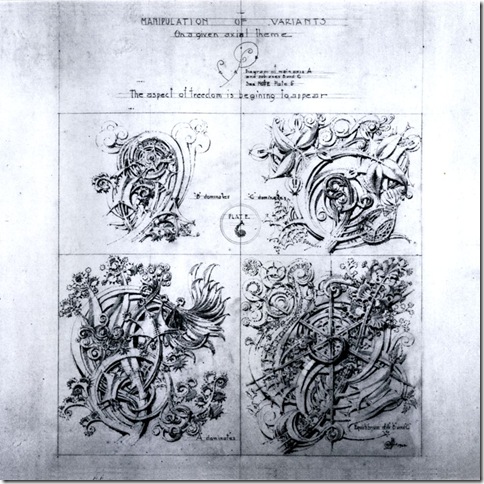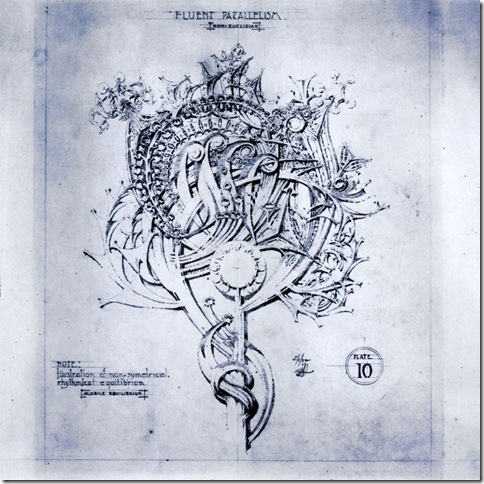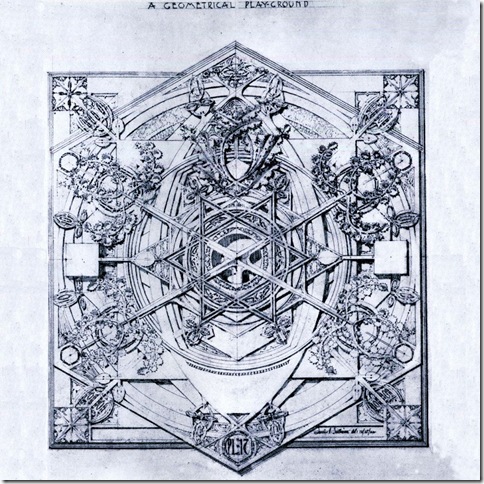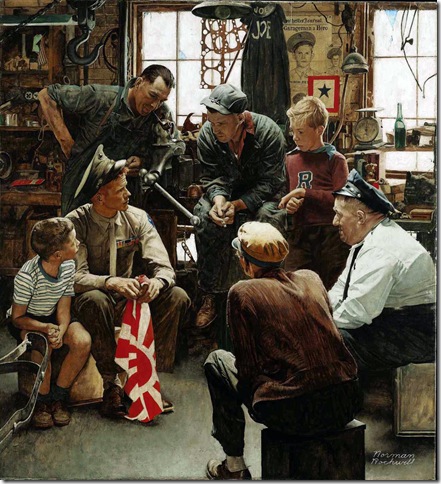Another six-pack of posts from my blog archives for your summer reading pleasure. Enjoy!
* * * *
Friday, June 17, 2005
The miracle of breakfast
There'll never be a perfect breakfast eaten until some man
grows arms long enough to stretch down to New Orleans
for his coffee and over to Norfolk for his rolls, and reaches up
to Vermont and digs a slice of butter out of a spring-house, and
then turns over a beehive close to a white clover patch
out in Indiana for the rest. Then he'd come pretty close to
making a meal on the amber that the gods
eat on Mount Olympia.”
- O. Henry
Of course, O. Henry wrote those words nearly a century ago, and even then was writing them with a bit of a wink. We need neither long arms nor a big breakfast table to feast on this breakfast of the gods -- we enjoy it now, as O. Henry did then. All that's needed is the division of labour and the freedom to trade; the long arms and 'invisible hand' of the market do the rest.
As Adam Smith said, "It is not from the benevolence of the butcher, the brewer or the baker that we expect our dinner, but from their regard to their own self-interest." The butcher, the brewer and the baker "direct [their] industry in such a manner as [their] produce may be of the greatest value," and we are the beneficiaries of their labours -- each "intends only his own gain, and he is in this, as in many other cases, led by an invisible hand to promote an end which was no part of his intention."
There's nothing miraculous about Smith's 'invisible hand,' it is simply the recognition that when each producer trades the fruits of their labour, they each win by that trade. In the words of the economists, when I trade my apples for my neighbour's oranges to the goods are moved from 'lower value' to a 'higher value'; that is, I value the oranges more than my apples, and my neighbour values my apples more than his oranges.
The sum result of this and every voluntary trade is that both traders win - everyone kicks a goal! -- and from each trade new wealth is created thereby: the economy is greater for the sum of the higher values achieved, and my breakfast table is richer by some freshly squeezed orange juice. The same is true when I pay for butter from Vermont to be brought to my breakfast table: the chain of trades necessarily increases the wealth of all involved.
Frederic Bastiat identified the miracle himself when observing that sleeping Parisians worried not about their next breakfast:
“On coming to Paris for a visit, I said to myself: Here are a million human beings who would all die in a few days if supplies of all sorts did not flow into this great metropolis. It staggers the imagination to try to comprehend the vast multiplicity of objects that must pass through its gates tomorrow, if its inhabitants are to be preserved from the horrors of famine, insurrection, and pillage. And yet all are sleeping peacefully at this moment, without being disturbed for a single instant by the idea of so frightful a prospect. On the other hand, eighty departments have worked today, without cooperative planning or mutual arrangements, to keep Paris supplied. How does each succeeding day manage to bring to this gigantic market just what is necessary - neither too much nor too little?”Bastiat of course knew the answer to this seemingly complex puzzle: what ensures that Paris is fed is freedom. More specifically, the freedom of every individual to think, choose, act, produce and to trade his produce with other individuals. By working to satisfy his own needs and wants, the free individual produces new values, and makes life better for all of us who have ourselves produced something to trade with him.
The 'miracle of breakfast' is that it is really no miracle at all. It is the fruit of freedom.
* * * *
Wednesday, August 17, 2005
“Drug use is not a victimless crime”
"Drug use is not a victimless crime" argued a friend recently. Drug users harm themselves and other people too, said my friend; they are all victims.
Well, as I've explained before, yes it is a victimless crime. Drug use may well make of the user a 'victim,' but as long as nobody initiates force against another, no crime is involved. As I explain here, a crime is when somebody does initiates force, or its derivative fraud, against someone else:
Cue Card Libertarianism – Force
In fact, that's what moral governments are set up for: not to protect us against ourselves, but to offer protection for each of us against the initiation of force by others. This gives us the 'moral space' in which to live our own lives in our own chosen way, as I point out here:
Cue Card Libertarianism – Government
Being free gives no guarantee of success. Freedom means we are free to succeed, and also free to fuck up. 'Free to get it right' means you must also be free to make mistakes. And being free means we must take responsibility for our actions and our mistakes, as I argue here:
In Dreams Begins Responsibility
So if you want freedom for yourself to win or to fail, then you must accept that same freedom for others too, which means you must accept freedom right across the board. You may disagree with another person's choice of recreational activity, but you are not morally entitled to bring down the weight of government force against them just for that.
Freedom is not something that you can cherry-pick; not something from which you can pick or choose according to your own prejudices; freedom is indivisible: allow a government to take freedom over here, and you have given it the power to also take freedom over there. Pretty soon freedom becomes challenged and tied up in all directions, and big government gets biggerand better at tying us up. By athat standard, any man's battle for his own freedom is our own battle too.
So a 'victimless crime' is one in which no force has been initiated against anyone else. If you choose to inflict harm against yourself that's your business. ~If~ you do. Drug use is a victimless crime--the classic textbook example of a victimless crime-- as I say here:
Cue Card Libertarianism – Drugs
Further, in the present environment of prohibition, it's no accident that organised crime and petty crime is intertwined, nor that organised crime is heavily involved with providing something that is illegal.
It's interesting that people such as Eddie Ellison, former head of the Scotland Yard Drug Squad, says he and many other British policemen have now come to the conclusion that practical policing means that drugs should be made legal. Making them legal, says Eddie and other practical policemen like him, removes drug profits and the control of drug quality from criminals and corrupt policemen, and slashes the costs enormously -- removing the need to steal to pay for drugs, and removing the criminal connection between drug supply and drug use.
Removing drug laws from the books means police can concentrate on protecting you and me from real crimes that ~do~ involve the initiation of force, instead of spending time, energy and effort on people committing 'crimes' only against themselves -- 'crimes' which are never going to stop: If it's not possible to keep drugs out of prison, then how in hell are you going to keep them out of people's home?
Frankly, too many people have a blind spot on this subject. Admit it. You do. Arguing for legalisation of drugs is not an endorsement of consuming drugs, any more that arguing for freedom of religion is endorsing going to church. It's simply arguing for freedom.
People will still say, "don't expect me to be happy paying for other people's lifestyle choices." Neither should any of us be made to, and there perhaps is the nub. None of us should be paying for the lifestyle choices of drug users, but nor should we for the lifestyle choices of racing-car drivers, skydivers, alcoholics, left-wing academics, people who eat too many pies or church-goers. The problem here is not with drug use per se, nor with the misunderstanding of victimless crimes: the problem lies in the ethic and existence of the welfare state, which demands that you do pay for the lifestyle choices of others.
When I hear the objectors to drugs call for the demise of the welfare state, I'll know they've understood the issue.
Here's the crux of it all: As long as people are using drugs without initiating force against anyone else and they're taking responsibility for their actions, then what they do is entirely their business. It's not yours. It's not mine. And it's not the business of Jim Anderton or any other Drug Czar either.
If users or suppliers ~do~ initiate force, then they should be convicted for that, and without any bullshit about 'diminished responsibility' either. But convictions for crimes in which there is no physical coercion is a victimless crime. That ain't hypocrisy, that's the truth of it. Drug use is a victimless crime.
So now let's let's translate the objection that my friend really has to legalising drugs. She says "Drug use is not a victimless crime," but what she really means is this: "I don't like drugs." Fine. Her business. I don't like Pink Floyd. But I don't demand that anyone write a law about it, nor do I ask for the criminalisation of otherwise law-abiding Pink Floyd users. There are many objections one can make about Pink Floyd users, but making them criminals is not a valid action.
* * * *
Monday, April 11, 2005
Sometimes breast isn’t always best
 Liz Weatherly, a mother of three from Torbay, is spearheading an effort to have the Human Wrongs Act amended to protect women who breastfeed on other people's property from being asked not to. The petition follows in the path of much other legislation ensuring that that the views of property owners are ignored, so she has every chance of succeeding.
Liz Weatherly, a mother of three from Torbay, is spearheading an effort to have the Human Wrongs Act amended to protect women who breastfeed on other people's property from being asked not to. The petition follows in the path of much other legislation ensuring that that the views of property owners are ignored, so she has every chance of succeeding.
Weatherly began her campaign when she was asked by an Auckland Early Childhood Centre not to breastfeed her nearly-three-year-old at the centre without first discussing it with the centre's owners. Instead she removed her child from the school, waited a year and then called the Holmes Show, who she told she was "not after publicity."
Yeah right. Don't mention the word 'grand-standing.'
Ms Weatherly has never apparently heard of the word 'weaning' either, so perhaps I could point her towards it now. While there, might I suggest that Ms Weatherly and her supporters read and reflect on the independence of the child, and the concept of private property, and the nature of choice.
The rest of us can read this: 'Why doesn't she just use a baby's bottle?'
* * * *
Wednesday, January 30, 2008
Tugendhat house - Mies van der Rohe
One of European modern architecture's early classics, this house was designed by Mies for for textile factory owner Fritz Tugendhat in Brno Czechoslovakia, 1928.
If it looks familiar, it's because so may of today's 'classics' are simply stylistic recyclings of Mies' early work—which were at their best were simply unstylish recyclings of much of Frank Lloyd Wright’s early Prairie Houses.
The villa was seized from its Jewish owners Fritz and Greta Tugendhat by invading Germans in 1939, and was never returned to the family.
Labels: Architecture, History-Twentieth_Century, Mies Van Der Rohe
* * * *
Friday, September 26, 2008
'A System of Architectural Ornament' - Louis Sullivan
"In these little masterpieces of poetic imagination,' said Frank Lloyd Wright in 1949 of Louis Sullivan's ornamental drawings produced around half-a-lifetime before, "the poet in him shines forth on the record as a free, independent spirit characteristic of the free of all time."
“'Wright,' he would say [when Wright worked under Sullivan] concerning details which I was trying (as yet by instinct) to work with T-square and triangle ... 'bring it alive, man! Make it live!' He would sit down at my board for a moment, take the HB pencil from my hand and, sure enough, there it would be. Alive!
“... He did "make it live."
“...Say this greatest feature of his work was esoteric. Is it any the less precious for that?
“Do you realize that here, in his own way, is no body of culture evolving through centuries of time but a scheme and "style" of plastic expression which an individual working away in this poetry-crushing environment ... had made out of himself? Here was a sentient individual who evoked the goddess whole civilizations strove in vain for centuries to win, and wooed her with this charming interior smile -- all on his own, in one lifetime too brief.
“... Although seeming at time a nature-ism (his danger), the idea is there: of the thing not on it; and therefore Sullivanian self-expression contained the elements and prophesied organic architecture. To look down on such efflorescence as mere "ornament" is disgraceful ignorance. We do so because we have only known ornament as self-indulgent excrescence ignorantly applied to some surface as a mere prettification. But with the master [Sullivan], "ornament" was like music; a matter of the soul...
The ornament shown here comes from Sullivan's 1924 book, A System of Architectural Ornament, According with a Philosophy of Man's Powers. Giles Phillips from MIT has a complete collection of the book's twenty plates, and a Flash presentation of the System based on a study of Sullivan's Guaranty Building (above) here at his website.
Labels: Architecture, Frank Lloyd Wright, Louis Sullivan
* * * *
Thursday, June 02, 2005
East Germany in East Auckland
Back in the twenties when the villas and bungalows that many Aucklanders love so much were being flung up across Auckland, and town planning and zoning regulations were still just a twinkle in a busybody's eye, about that time a young Swiss poseur called Le Corbusier began promoting something he called the Radiant City. Here it is below.  If you find 'radiant' the thought of row upon row of grey, unappealing concrete boxes full of bourgeois-proofed worker housing hovering above a barren and hostile landscape, then you'll find Corbusier's city is just the thing for you and your authoritarian worship -- and perhaps you should move to the former Soviet bloc where decidedly radiant bourgeois-proofed cities jam-packed full of this kind of wall-to-wall worker housing were thrown together, and into which people from Leipzig to Vladivostok were thrown. East Germany’s Halle-Neustadt shown below is an example of this appallingly inhospitable place -- ‘Hanoi’ as its residents
If you find 'radiant' the thought of row upon row of grey, unappealing concrete boxes full of bourgeois-proofed worker housing hovering above a barren and hostile landscape, then you'll find Corbusier's city is just the thing for you and your authoritarian worship -- and perhaps you should move to the former Soviet bloc where decidedly radiant bourgeois-proofed cities jam-packed full of this kind of wall-to-wall worker housing were thrown together, and into which people from Leipzig to Vladivostok were thrown. East Germany’s Halle-Neustadt shown below is an example of this appallingly inhospitable place -- ‘Hanoi’ as its residents
so on came to call it.
on came to call it.
Corbusier's 'radiant city' was also very popular with western planners after the war when zoning regulations and town planning took hold with a vengeance. The plans were never popular with the people who had to live in them however. The Pruitt Igoe housing complex in St Louis (below) was eventually blown up when it became apparent that like many 'brave-new-world' housing projects blowing up was actually the only solution for it.
As the schemes for worker housing  became increasingly uninhabitable, the plans for radiant cities drawn up by planners quietly began to be shelved, but the town planners themselves were harder to get rid of, and they began to look around for other pastures to pollute.
became increasingly uninhabitable, the plans for radiant cities drawn up by planners quietly began to be shelved, but the town planners themselves were harder to get rid of, and they began to look around for other pastures to pollute.
Jane Jacobs pointed out in The Death and Life of American Cities that some of the places so hated by Corbu and the planning fraternity actually worked very well. The ‘mixed use’ of streets of terraced housing and brownstones in places like Manhattan she pointed out are very good places to live, with private houses often cheek by jowl with shops, cafes, and the like all an easy walk away. People choose to live in such places because they like them.
So too with the explosion of the suburbs – people everywhere including NZ like living in their own house in the suburbs. But planners hate suburbs. Too bourgeois! And they never really understood Jane Jacobs. They drew up plans that zoned the hell out of everything, ensuring that ‘mixed-use’ became a dirty word, and restricted the density of suburban subdivisions, thus ensuring more of the sprawl they are so against.
Planners hated suburbs all the more for the sprawl they themselves created. American suburbs are “a chaotic and depressing agglomeration of building covering enormous stretches of land,’ said, not a planner, but a book titled ‘The New Communist City’ produced by Moscow State University, whose graduates has designed Halle-Neustadt. Western planners agreed with those graduates, and bought into their “search for a future kind of residential building leading logically to high-density, mixed-use housing.”
Thus was born a new movement called ‘Smart Growth’ that eager young planners have subscribed to in droves. Portland, Oregon is the home of this drivel, and as an eager young Portland planner told a reporter in the late sixties, "We got tired of protesting the Vietnam War, read Jane Jacobs, and decided to take over Portland." They did, and the city is only now beginning to recover.
With the zeal of those for which there is only ‘one true way,’ smart-growth advocates gloss over Jacobs’s’ key point that choice is the key to what makes some places work and other places just suck, and they declared that everyone must live in the one true way prescribed by the planning profession. In Auckland we now have a document to ensure that everyone will.
‘Plan Change 6’ from the Auckland Regional Council sounds like it could have been written by that same team of Moscow State University graduates who built Halle-Neustadt, and it reads the same way. The document has been written with one eye on the Radiant City and the other on the public transport network that exists only in the heads of city planners.
Under ‘Plan Change 6’ no growth or activities will be allowed outside the Metropolitan Urban Limits, or outside existing town centres without the express permission of ARC planners. None. Countryside living according to this document is “unsustainable” and “undermines public transport.” How they must hate people making choices for themselves! This provision is in essence a plan to end countryside living and to make rural New Zealand a National Park.
Meanwhile, inside the Metropolitan Urban Limits plans are taking shape to force developers to build the slums of tomorrow. All development must take cognisance of the ARC’s plans for the public transport that doesn’t really exist and that few care to use. Minimum densities and minimum heights are prescribed for developments near transport ‘hubs.’ ‘Sprawl’ and private cars are the enemy, and gross intensification is the answer prescribed by the ARC planners.
If you felt yourself wanting to Sieg Heil as you read all this then go right ahead – you’re on the right track with where it’s all heading.
Under ‘Plan Change 6’ from the ARC, as the old joke goes, whatever is not illegal has become compulsory. Countryside living is to become banned; new suburbs discouraged; high density intensification the wave of the future. And the very villas and bungalows that are loved so much and were thrown up back before planning was born are now to be protected in heritage zones, even as council plans strive to ensure that such swathes of ‘unsustainable’ suburbia are never built again.
And the choice of people to live where they want in the manner of their own choosing will once again be taken from them by the zealots of central planning.
O brave new world! O worker housing! "Oh," as many Aucklanders might now be thinking, "My God!"
* * * *
Wednesday, July 16, 2008
'The Homecoming Marine' (1945) - Norman Rockwell
I must confess that I’m not an admirer of the paintings of Norman Rockwell, but I do admire the masterful analysis of art. Nick Provenzo's illuminating discussion of this Rockwell classic, of what seems at first glance just a simple naturalistic painting, is a signal lesson in how to begin analysing a figurative painting -- or any real artwork. It's first rate.
The key is to understand that nothing in art is accidental -- the artist has chosen everything with some purpose in mind. Everything is intentional; it's the viewer's task to answer the why.
Labels: Art
* * * *
Thanks for reading. Here’s two sisters singing Offenbach:





2 comments:
There was a component to the "perfect breakfast" which I think you might have missed/glossed over, and it was the entire point of the long arms. Freshness. :)
If you think Plan Change Six is bad – and it is – then read part six of the Third Auckland Governance Bill and note that it promotes rabid spatial planning (the new code word for Smart Growth) without any due process or rights of appeal. Just "consultation".
The one benefit of the RMA compared to most collections of land use law elsewhere in the world is that it was a one stop shop with one time line. But starting with the Long Term Community Plans this principal has been under seige and now we have a council being able to mandate and decide on all land use decisions and presumably override any decision of the Environment court.
Post a Comment